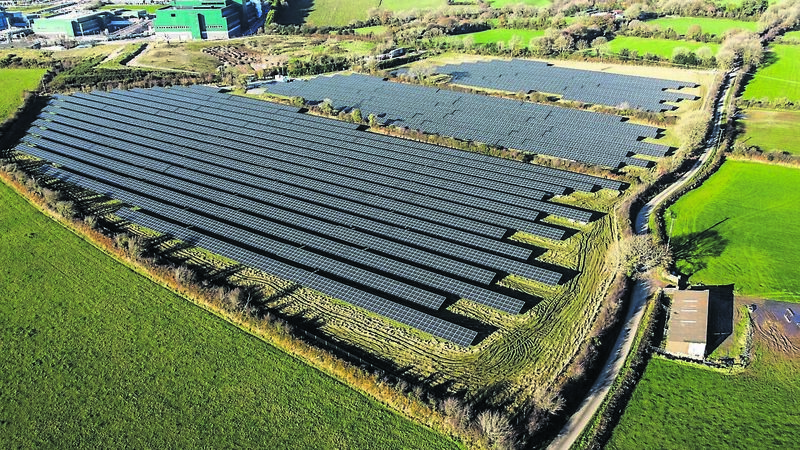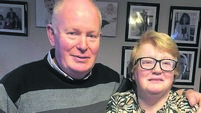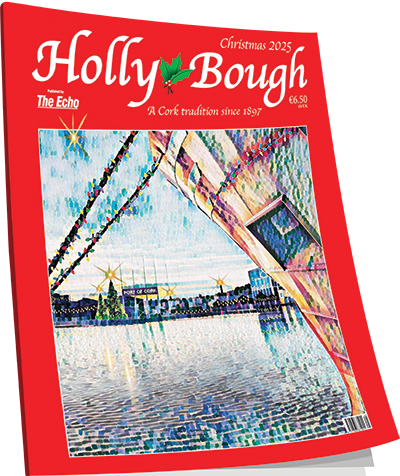Cork is ready to reap a solar power revolution

PLANNING FOR A BRIGHTER FUTURE: Ireland’s largest solar farm, at the Eli Lilly plant at Dunderrow, near Kinsale.
WITH dozens of planning applications submitted across Cork for the development of new solar farms, the county is set for something of a solar revolution in the coming years.
Wind power is now a well established source of renewable energy, with turbines a common sight on Cork’s hillsides, but so far solar power has not been developed to anything like the same extent.
To date, just one solar farm is in operation in Cork, providing power to the Eli Lily plant at Dunderrow, near Kinsale, but that is set to change soon, with numerous planning applications at various stages for proposed new solar farms across the county.
Within the next two to three years, solar farms could be generating power across the county at sites including Ballincollig, Charleville, Clonakilty, Cloyne, Crookstown, Dunmanway, Fermoy, Inniscarra, Kanturk, Kilmoney, Mallow, Midleton, Timoleague, and Whitechurch.
The solar boom is part of Ireland’s drive to meet 80% of our electricity needs from renewable sources by 2030, and the key to doing this is by introducing a broad range of energy options, including wind, wave and solar generation.
According to Cork Green Party councillor Dan Boyle, the targets are very achievable if there is the will to make it happen.
“It’s all about having a mix of options, and solar is going to be an important part of that mix. Many people assume that it’s not sunny enough in Ireland for solar power, but that’s not the case, all you need is daylight and we have plenty of that,” he said.
“When you have a range of options you are not relying on one type of power generation and ultimately we should be aiming to produce all our energy needs from renewable sources.
“We have wind turbines but the wind doesn’t always blow, but you can have a bright sunny winter’s day with no wind, so your solar can play its part, and we are surrounded by water and the potential for tidal energy has hardly been exploited so far,” he added.
According to Kieran Lettice, Cluster Manager at Energy Cork, an industry group dedicated to promoting energy research and production in Cork, the Rebel County is in a great location to take maximum advantage of Ireland’s solar power potential.
“Here in Cork we really are ideally located,” he said. “We have an extensive coastline, we have hills and mountains and can take advantage of the prevailing Atlantic winds, and when it comes to solar we are in the sunniest part of the country.”
He added: “If you compare the solar energy potential here in Cork, you could be looking at as much as 10% more energy generated at a location here than further north in Ireland, which is a significant amount.”
According to Mr Lettice, the reason that the solar industry in Cork and Ireland has not yet become a major part of our energy plans is simple: cost. But that is now changing because of, he says, “in one word, China”. “In the past 10 or 15 years, the Chinese have really taken to solar in a big way. What that means in practical terms is that the cost of solar technology has fallen dramatically because of the vast scale of the Chinese industry.
“For places like Ireland, it has made the technology far more affordable and solar has gradually become a realistic option, and that’s why we are now seeing real development in the sector here.”
With solar becoming more affordable, there has been a huge increase in planning applications for solar farms - these are commercial scale developments that can supply electricity to the national grid.
“One of the major benefits of solar farms it that they are relatively easy to conceal in the landscape, especially compared to wind farms.
Mr Lettice said: “Well, for a start there are no moving parts so you don’t have potential problems with noise or vibrations.
“They are also low to the ground, so with most relatively level sites solar farms can be well concealed with some careful planting.”
Solar farms also have the potential to regenerate former industrial sites. A planning application was recently lodged for a site near Dunmanway where a disused quarry could be tuned into a solar farm, an approach that has been used successfully in many other countries.
“There can be added benefits,” said Mr Lettice. “Solar farms can have mixed planting around the site but also between the solar arrays. You can have meadows and hedgerows, and animals can also make use of the shelter from the panels too, so with some imagination you can actually create more diverse habitats than what is being replaced.”
The Government has committed to supporting renewables through the Renewable Electricity Support Scheme (RESS).
RESS will provide up to €12 billion in financial support to the sector up to 2030 through the Public Service Obligation Levy, the idea being to give investors the confidence of a guaranteed return, which will gradually decrease as renewables become a bigger and bigger part of the mix.
Community schemes will also be encouraged and Energy Cork is supporting the first community solar scheme in Cork.
“The community scheme we are supporting at Lurrig, near Whitegate is the first of its kind in Cork,” said Mr Lettice.
“It’s a 5.2 MW solar farm that will be feeding directly into the local grid and hopefully will be the first of many such schemes across the county.”
With current inflationary pressure, it may be that some of the proposed solar farms will be delayed, but according to Mr Lettice the momentum is now there to see a major transformation in how our energy is generated.
“There will always be problems and issues but there is a real feeling that the time is now,” he said.
“There is real enthusiasm in the sector and we have the technology, it is just a case of making it happen.
“Per unit of electricity, we generate we emit about 75% fewer greenhouse gases now than we did 30 years ago, that’s real progress and those numbers are only going in one direction,” he concluded.






 App?
App?





